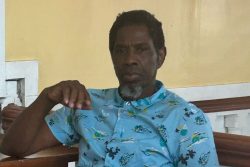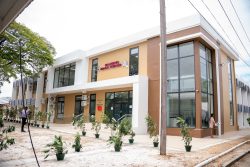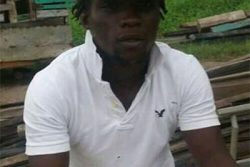 As a young child, I loved accompanying my stout father, “Mr. Big” to the city sea wall for his regular swim after a long, exhilarating walk along the Fort Groyne, a weathered, narrow concrete erosion barrier bolstered by great granite boulders, jutting out into the ocean like a giant index finger at the far end of breezy Kingston.
As a young child, I loved accompanying my stout father, “Mr. Big” to the city sea wall for his regular swim after a long, exhilarating walk along the Fort Groyne, a weathered, narrow concrete erosion barrier bolstered by great granite boulders, jutting out into the ocean like a giant index finger at the far end of breezy Kingston.
While he waded out past the squelchy flats, to exercise in the deeper waters made dull and murky by Amazonian mud, I would stand barefoot on the warm, brown sand beach to shout and squint at him, a mere dot, bouncing up and down in the restless waves. Racing in the surf along the rich shoreline, hair streaming in the steady, salty wind, I would search for shells, stones, sticks, specimens of driftwood and sea glass gems washed smooth by the frothy Atlantic.
Among the flotsam, bright green seaweed and carpet of creepers would gleam the beautifully deceptive Portuguese man-of-war, a fascinating, fragile, frilled bright blue balloon, transparent in the sun with its delicately tucked upper purplish polyp for which it is named, given the ready resemblance to the famed Latin battleship at full sail. The thin tendrils covered with venomous pearl-like cells would extend in a tangled trail of moist curls or be clumped in a thick, dark, mysterious blob.
A siphonophore, the “blue bottle” or “floating terror” is an unusual animal that lacks tissues and organs. It really constitutes a colony of four genetically identical organisms specialized for distinct tasks but working together. One day, intrigued by the curious creature that drifted in with the currents, I bent to pick up the ethereal gas bladder when my family, who had accompanied us, screamed at me in a chorus to drop it.
I was reluctant, protested loudly and was properly scolded about potential painful passing from the powerful poisons, so I drifted on to ponder other finds, including the endless, small coloured bottles that lay scattered among the detritus. Later that day, as I watched more of my newfound treasures hurled away, I quickly learnt to my chagrin that no corked glass container like the alluring “blue bottle”, regardless how extremely pretty the hue, was to be even touched, and God forbid, retained and opened.
Folktales abound of the temperamental forces that supposedly lie trapped in these fragile receptacles waiting to be set free by the unsuspecting, their tiny size belying their gargantuan abilities and ginormous appetites. Of West African origin, according to the late Guyanese linguist and lexicographer, Dr. Richard Allsopp, the word “baccoo” stems from “ba-ku” meaning death/corpse and led to the Saramaccan, “bakulu,” a dwarf-spirit. In colonial days, it spread through the Guianas and to the Eastern Caribbean.
The “baccoo” is “an active, wicked spirit believed to take the form of some small, living, partly human being that must be kept in a bottle and may be commanded either to bring its owner great wealth or to do harm to other persons,” according to Dr. Allsopp, a Creole expert in his hallmark “Dictionary of Caribbean English Usage.”
“Bacuba”
With an almost unquenchable lust for the “bacuba” or reddish “buck” bananas and milk, the mythological figure sometimes misbehaves like a pugnacious poltergeist by abruptly moving items, pelting homes with showers of rocks and causing general mayhem. Suspicious displays of riches are put down to a well-fed “baccoo” but since they invariably tend to be mischievous, intelligent and deceitful, the infernal beings shapeshift and turn invisible, tormenting their owners when the mood, madness and hunger strike.
An internet contributor with the humourous handle “Little Two Two” writing of Guyanese “jumbies” on the “Exemplore” website, recites the account of an individual who naturally kept his “baccoo” high on a ledge out of sight, using a ladder to reach him nightly.
“On the eve that this man had to go out of town, he instructed his servant to feed the beast but to keep his eyes averted. The owner knew how devious and cruel the `baccoo’ could be. When the servant went to feed it, he naturally looked to see what it was that was kept up high on the shelf. He was greeted by a huge black snake that appeared and the servant was so startled, he fell off the ladder and broke his neck.”
Another popular tale tells of a pair that held a village hostage by raining rocks on the houses, breaking windows and injuring residents, “Little Two Two” added. He recalled, “My father in law, who is from the Demerara area, specifically the West Coast, talked of two `baccoos’ named Boya and Boysie. They lived in Stewartville, on the Old Road. If anyone said anything (negative) about them or even `baccoos’ in general, they would get upset and bad things would happen to whomever said it.” Older people reported the entities “have caused objects in a house to start flying around and even once covered a man in feces for bad mouthing them.”
Acquisition
With all the sudden, mysterious acquisition of wonderful wealth in the last few decades by a privileged few in Guyana, local “baccoos” and the like must be bountiful and far too busy, hard at work. As the sources of such affluence apparently metamorphose, and the paper and money trail disappears, entailing a flood of forensic audits ordered by the current administration into publicly-financed bodies, citizens are still to see congruent action in terms of solid Police investigations into the malfeasance leading to arrests and successful prosecutions.
The latest public revelations follow a damning forensic audit of the semi-autonomous Guyana Office for Investment (Go-Invest) by Chartered Accountant, Nigel Hinds and his Financial Services practice, which identified numerous problems and concluded that following over 20 years of operations, the agency has dismally failed to fulfill its promised mandate of promoting and facilitating open private sector investment and exports.
Reporting that the organisation is plagued with poor governance, accountability breaches, mismanagement and no strategic plan, the report pointed to alarming irregularities including a personally directed remuneration policy, and the glaring absence of an Audit Department and standard operating procedures for different sections. It found no policy for investment deals under the former Chief Executive Office, (CEO), Keith Burrowes compounded by an “appalling” and “inexcusable” filing system for such key documents.
The auditors discovered that Burrowes, appointed in 2014, misused his authority as evident in several transactions, including where he took personal loans amounting to over $3.2M, without approval from the Board, which he had previously chaired. The monies were eventually repaid by February last year but the review referred to his various “ad hoc and peculiar decisions.” He instructed that Go-Invest pay his personal driver, gave himself a $480 000 entertainment allowance and used over $1M for phones for his driver, a financial consultant and senior staff.
Indeed, an examination showed there were no minutes of Board meetings for the whole of 2012, while just two monthly sets were listed for 2013, one for January 2014, and five for 2015, contrary to the decision to meet every third Tuesday. Only a pair of minutes were signed by the Chairman and Board Secretary, while no members of the Guyana private sector were ever on the Board, during the review period.
“As a result, the CEO was invariably operating without oversight from the Board of Directors,” the report noted. Burrowes stepped down in 2015.
The former CEO, Mr. Desmond Mohamed claimed he was not supported by the then Chairman, Burrowes, who he informed the investigators, “frustrated and interfered with Executive functions” prompting the decision from high up to have Mohamed revert to his substantive position at the Guyana National Shipping Corporation in 2012 and two Senior Investment Officers take over the running of Go-invest for nearly one and a half years.
“We were informed by Go-Invest that select Investment Agreements that would normally fall within the remit of Go-Invest were directly processed by the Office of the President (OP). Thus, Go-Invest is not in a position to provide any information on such investment applications or agreements. The Procurement Act of 2003 was not followed or referenced based on our investigations. Procurement decisions were made invariably without any Invitation for Bids or for three quotations. Also, the procurement policy used by Go-Invest was not documented.”
Based on discussions with senior management, the group said that some Investment Agreement (IA) proposals were sometimes managed directly by OP inclusive of concessions being recommended for investors, and these were not shared with Go-Invest.
Advances
Disclosing that the Board of Go-Invest wrote off uncleared advances to former Minister of Trade and Tourism Mr. Manniram Prashad amounting to $1.2M as bad debts, the team identified $161,124 of similar advances by former CEO, Mr. Geoffrey DaSilva.
“There was no evidence that Go-Invest reviewed and made recommendations annually for changes to the priority list of Regions in Guyana for creating employment in fields such as non-traditional agricultural development, information and commutation technology, petroleum exploration, extraction and refining, value added wood processing, among others – as is required by Section 2 of the Income Tax in Aid of Industry Act of 1994.”
Chinese logging business Bai Shan Lin received multiple concessions that exceeded a whopping $1.8B from 2012 to 2015, without honouring their commitment to set up and operate a wood processing factory in Guyana, the document pointed out. While the firm received its first investment pact a decade ago under the previous People’s Progressive Party (PPP) Government, there is no record of the measures from the agency or the Guyana Revenue Authority (GRA) “due to lax monitoring mechanisms.”
Bai Shan Lin’s huge grant of over 627,072 hectares has since been repossessed by the Guyana Forestry Commission (GFC). Others also breached their investment accords, such as the Indian firm, Vaitarna Holding which controls a massive 737,814 hectares of forest, and received $217M in concessions from 2011 to 2014 to set up sawmilling and significant value added industries. Guyana’s Diamond Tropical Wood Products with $60M, and the Chinese Zhonghao Shipyards, $82.4M were named too.
“In many instances, files examined had un-dated draft Investment Agreements, which undermined the integrity of the documentation process for a key area of Go-Invest responsibilities. This opened the verification and review process to opportunities for forgery and undermined the use of an audit trail.”
Multiple times, the auditors requested from the GRA information on allowances granted to other investors with Approved Investment Agreements, but none was forthcoming. These cover Buddy’s Hotel Royale, Quark Communications, E-Networks, Sleep-In International Hotel and Casino, the New Guyana Pharmaceutical Corporation (GPC), Global Packaging, Sun and Sand Mining and Mineral Resources (UK), Diamond Tropical Woods, Decopav Concrete Products, NHL Alproguy, Global Printing and Graphics, Health International, Monica Beepat trading as Giftland Office Max, Global Hardware and Movietowne which runs the popular complex of the same name in Trinidad and Tobago and is building another huge, multi-cinema operation promising “first class entertainment” in Guyana, while seeking more lands.
ID warns that if you intend to do business in Guyana, do not attempt to open any strange corked bottle floating in the land of many waters or else you may be stuck for all eternity spending money providing bananas, milk and honey to insatiable “baccoos,” that are more dangerous than any man-of-war.








